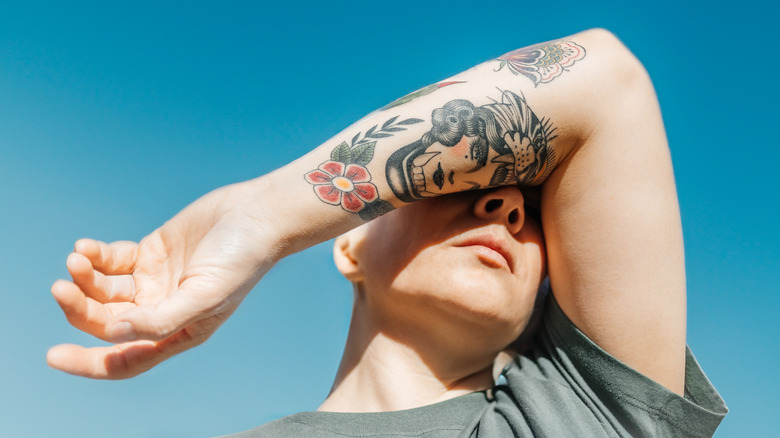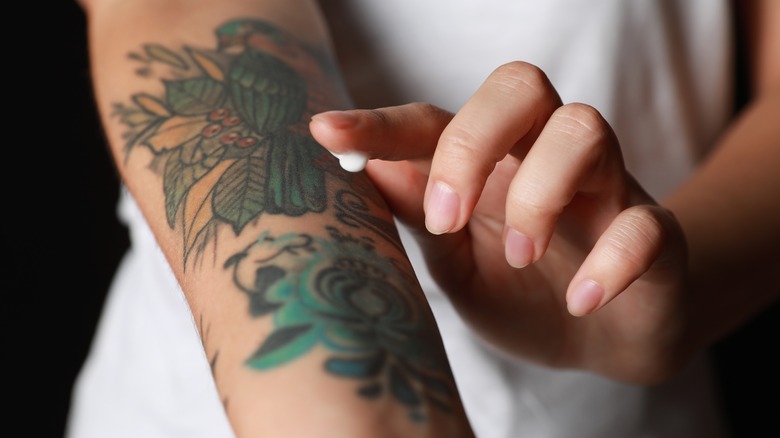5 Body Parts Where Tattoos Are More Likely To Fade
Getting a tattoo is both a statement and an investment. It takes time and money to sit for new ink, not to mention the occasional blood, sweat, and tears. Whether you're more into classic pieces, bold and poppy new-school designs, or delicate fine-line tattoo styles, it's only natural that you'd want to protect your body art and keep it looking fresh and vibrant for as long as possible.
However, not all tattoos will age the same, and placement can be a critical factor in this. To find out which areas need particular TLC, Glam spoke exclusively to micro and fine-line tattoo artist Syd Smith, owner of Syzygy Precision Tattooing. Smith revealed that certain parts of the body are at higher risk of fading over time — most notably, the hands and fingers, the feet and ankles, the elbows and inner elbow (an area sometimes called "the ditch"), the knees, and the inner lip. But what makes the skin at these spots so vulnerable, and how can you protect your tattoos there? We asked, and Smith provided answers.
Friction, sunshine, and thin skin make some areas prone to fading ink
When planning your next tattoo, you're probably considering design, aesthetic placement, and maybe even the pain level of different tattoo spots. With all this to think about already, you probably aren't making decisions based on longevity. But as we now know, there are five body parts that are particularly susceptible to fading. Thankfully, Syd Smith explained why. "These areas are prone to fading because they experience more friction and movement, as well as increased sun exposure," Smith exclusively informed Glam. "Hands, fingers, feet, and ankles, for instance, are constantly exposed to the elements and come into contact with various surfaces throughout the day. Elbows and knees are also places where the skin bends and stretches frequently, causing the tattoo to lose its sharpness over time." In short, skin that tends to be rough, calloused, or stretchy can mean a shorter lifespan for your tattoo.
Skin thickness can also play a role, especially in delicate areas like inside the mouth. "As for the inner lip, if done right, it can last forever," Smith explained, adding, "Lip tattoos heal quickly because the mouth is close to blood vessels and is constantly wet." However, Smith revealed that lip tattoos can sometimes be fleeting. "These areas tend to have thinner skin or fewer layers of skin to hold the ink, making the tattoo more susceptible to fading."
Say it ain't so. We had high hopes for a peekaboo lip design or trendy cuticle tattoos, but Smith named these among the five areas most likely to fade. What's an ink enthusiast to do? Apart from avoiding certain placements outright, isn't there any way to increase the durability of your body art, even in vulnerable spots?
Aftercare and skincare are the keys to long-lasting tattoos
Caring for your tattoo is a long-term process, but it starts as soon as your artist lifts the needle from your skin. First and foremost, your ink needs to heal well to last well. "Avoid excessive friction, such as tight clothing or jewelry rubbing against the tattooed area, particularly during the healing process," Syd Smith exclusively told Glam, explaining that the healing process can last anywhere from two to six weeks. During this time, keep an eye out for signs that your tattoo isn't healing properly, like extreme redness, inflammation, or itchiness. And for goodness' sake, give your skin some time to recover. As Smith instructed us, "Follow proper aftercare when the tattoo is fresh, including avoiding submerging the tattoo in water for extended periods and not picking at scabs."
Once your ink is healed, you can continue protecting it with a skincare routine geared toward major causes of fading, namely by fighting off sun damage and improving hydration. "Use a high SPF sunscreen to protect your tattoos from UV rays," Smith recommended, adding, "Keeping your tattoo moisturized with a hydrating lotion will help maintain the skin's elasticity and prevent dryness, which can cause fading."
Of course, some amount of eventual fading is natural, even if you're taking A+ care of your tattoos. Fortunately, this can be remedied with a quick visit to your favorite tattoo artist. As Smith urged, "Once you notice fading, it's a good idea to reach out to your artist for a touch-up! They can reapply ink to bring back the vibrancy of the tattoo."


